Analyzing Calculator Use in Math: Research Results and Findings
VerifiedAdded on 2023/06/15
|7
|1644
|292
Report
AI Summary
This research report explores the use of calculators in mathematics education, presenting findings from pretest and posttest scores. The study investigates the impact of calculators on calculation speed, accuracy, and problem-solving approaches among students. Results indicate that calculators can save time and reduce errors, particularly in moderate to difficult calculations, allowing students to focus on deeper understanding and application of mathematical concepts. The report also acknowledges limitations of the study, such as small sample size and sampling techniques, and suggests future research directions, including exploring socio-economic factors and varying difficulty levels. The conclusion emphasizes the importance of controlled calculator use to enhance learning without compromising fundamental mathematical skills. Desklib provides access to similar assignments and study tools for students.
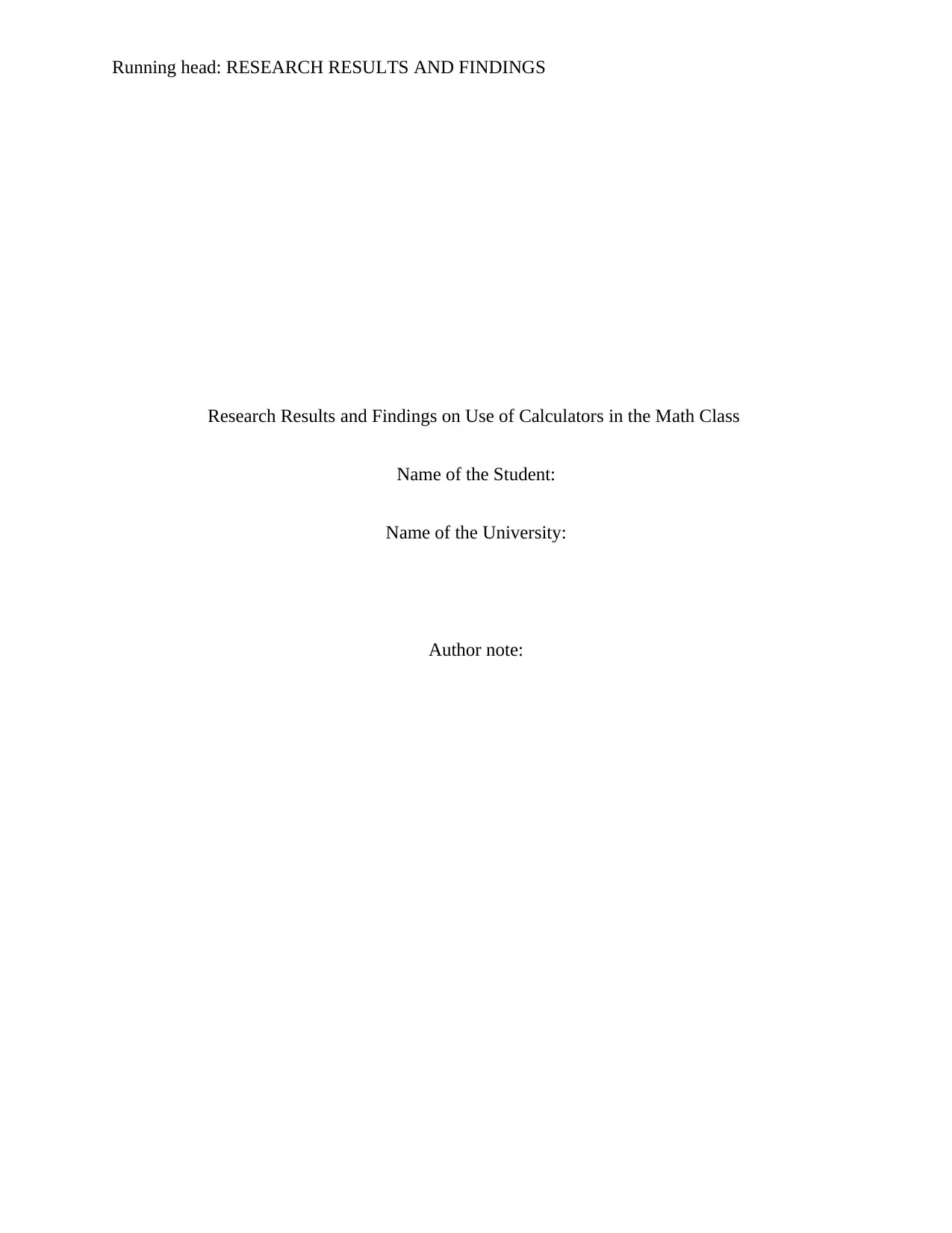
Running head: RESEARCH RESULTS AND FINDINGS
Research Results and Findings on Use of Calculators in the Math Class
Name of the Student:
Name of the University:
Author note:
Research Results and Findings on Use of Calculators in the Math Class
Name of the Student:
Name of the University:
Author note:
Paraphrase This Document
Need a fresh take? Get an instant paraphrase of this document with our AI Paraphraser
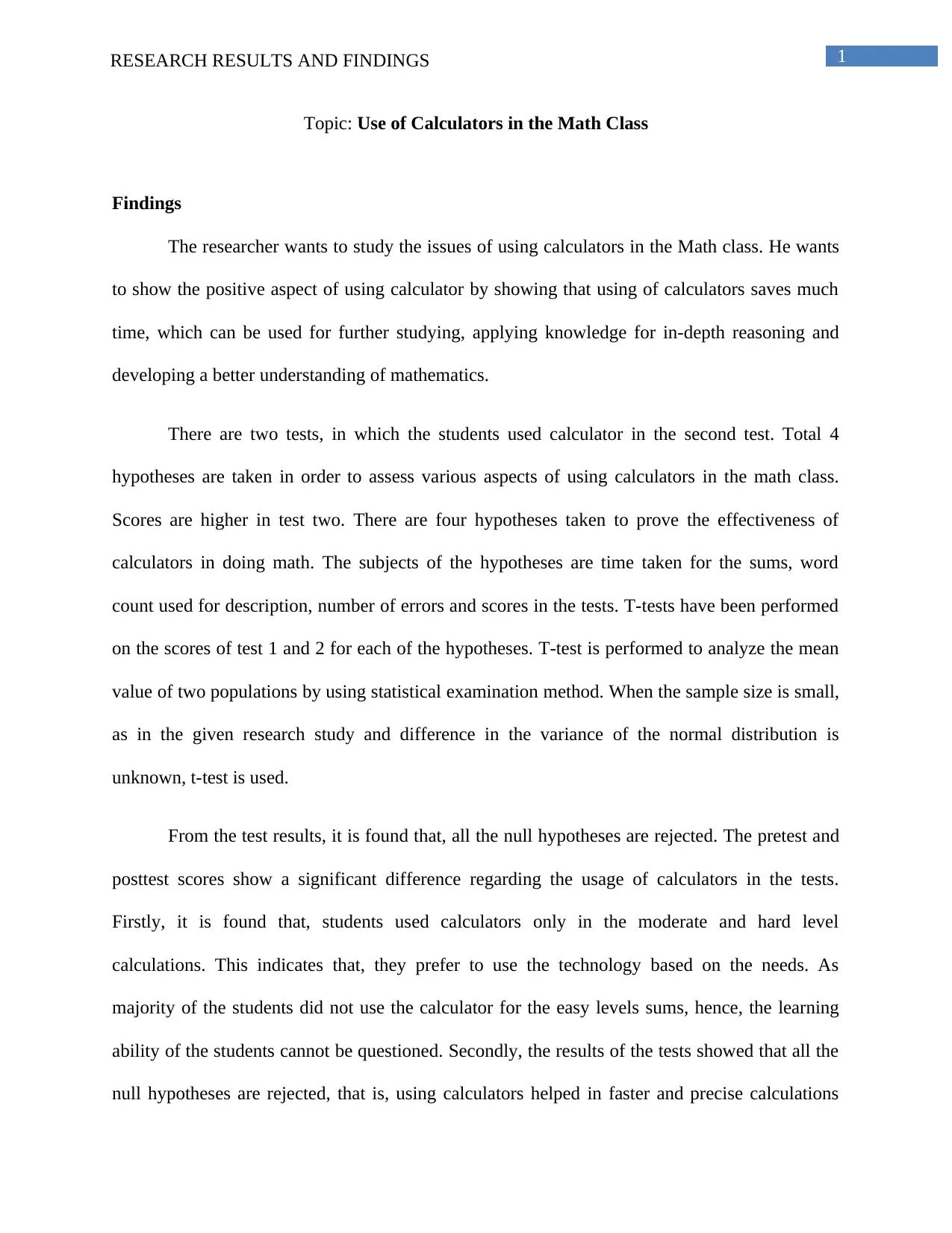
1RESEARCH RESULTS AND FINDINGS
Topic: Use of Calculators in the Math Class
Findings
The researcher wants to study the issues of using calculators in the Math class. He wants
to show the positive aspect of using calculator by showing that using of calculators saves much
time, which can be used for further studying, applying knowledge for in-depth reasoning and
developing a better understanding of mathematics.
There are two tests, in which the students used calculator in the second test. Total 4
hypotheses are taken in order to assess various aspects of using calculators in the math class.
Scores are higher in test two. There are four hypotheses taken to prove the effectiveness of
calculators in doing math. The subjects of the hypotheses are time taken for the sums, word
count used for description, number of errors and scores in the tests. T-tests have been performed
on the scores of test 1 and 2 for each of the hypotheses. T-test is performed to analyze the mean
value of two populations by using statistical examination method. When the sample size is small,
as in the given research study and difference in the variance of the normal distribution is
unknown, t-test is used.
From the test results, it is found that, all the null hypotheses are rejected. The pretest and
posttest scores show a significant difference regarding the usage of calculators in the tests.
Firstly, it is found that, students used calculators only in the moderate and hard level
calculations. This indicates that, they prefer to use the technology based on the needs. As
majority of the students did not use the calculator for the easy levels sums, hence, the learning
ability of the students cannot be questioned. Secondly, the results of the tests showed that all the
null hypotheses are rejected, that is, using calculators helped in faster and precise calculations
Topic: Use of Calculators in the Math Class
Findings
The researcher wants to study the issues of using calculators in the Math class. He wants
to show the positive aspect of using calculator by showing that using of calculators saves much
time, which can be used for further studying, applying knowledge for in-depth reasoning and
developing a better understanding of mathematics.
There are two tests, in which the students used calculator in the second test. Total 4
hypotheses are taken in order to assess various aspects of using calculators in the math class.
Scores are higher in test two. There are four hypotheses taken to prove the effectiveness of
calculators in doing math. The subjects of the hypotheses are time taken for the sums, word
count used for description, number of errors and scores in the tests. T-tests have been performed
on the scores of test 1 and 2 for each of the hypotheses. T-test is performed to analyze the mean
value of two populations by using statistical examination method. When the sample size is small,
as in the given research study and difference in the variance of the normal distribution is
unknown, t-test is used.
From the test results, it is found that, all the null hypotheses are rejected. The pretest and
posttest scores show a significant difference regarding the usage of calculators in the tests.
Firstly, it is found that, students used calculators only in the moderate and hard level
calculations. This indicates that, they prefer to use the technology based on the needs. As
majority of the students did not use the calculator for the easy levels sums, hence, the learning
ability of the students cannot be questioned. Secondly, the results of the tests showed that all the
null hypotheses are rejected, that is, using calculators helped in faster and precise calculations
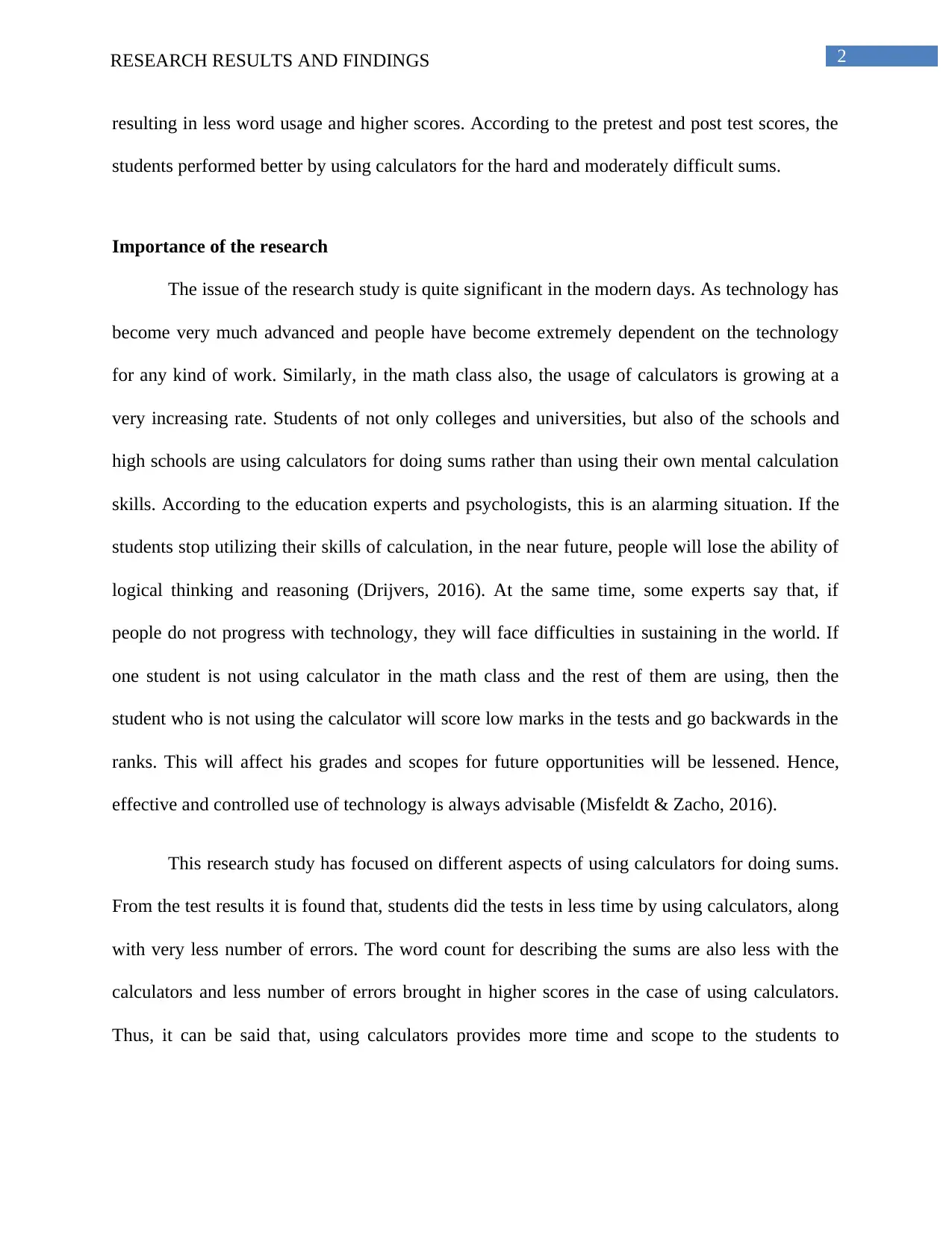
2RESEARCH RESULTS AND FINDINGS
resulting in less word usage and higher scores. According to the pretest and post test scores, the
students performed better by using calculators for the hard and moderately difficult sums.
Importance of the research
The issue of the research study is quite significant in the modern days. As technology has
become very much advanced and people have become extremely dependent on the technology
for any kind of work. Similarly, in the math class also, the usage of calculators is growing at a
very increasing rate. Students of not only colleges and universities, but also of the schools and
high schools are using calculators for doing sums rather than using their own mental calculation
skills. According to the education experts and psychologists, this is an alarming situation. If the
students stop utilizing their skills of calculation, in the near future, people will lose the ability of
logical thinking and reasoning (Drijvers, 2016). At the same time, some experts say that, if
people do not progress with technology, they will face difficulties in sustaining in the world. If
one student is not using calculator in the math class and the rest of them are using, then the
student who is not using the calculator will score low marks in the tests and go backwards in the
ranks. This will affect his grades and scopes for future opportunities will be lessened. Hence,
effective and controlled use of technology is always advisable (Misfeldt & Zacho, 2016).
This research study has focused on different aspects of using calculators for doing sums.
From the test results it is found that, students did the tests in less time by using calculators, along
with very less number of errors. The word count for describing the sums are also less with the
calculators and less number of errors brought in higher scores in the case of using calculators.
Thus, it can be said that, using calculators provides more time and scope to the students to
resulting in less word usage and higher scores. According to the pretest and post test scores, the
students performed better by using calculators for the hard and moderately difficult sums.
Importance of the research
The issue of the research study is quite significant in the modern days. As technology has
become very much advanced and people have become extremely dependent on the technology
for any kind of work. Similarly, in the math class also, the usage of calculators is growing at a
very increasing rate. Students of not only colleges and universities, but also of the schools and
high schools are using calculators for doing sums rather than using their own mental calculation
skills. According to the education experts and psychologists, this is an alarming situation. If the
students stop utilizing their skills of calculation, in the near future, people will lose the ability of
logical thinking and reasoning (Drijvers, 2016). At the same time, some experts say that, if
people do not progress with technology, they will face difficulties in sustaining in the world. If
one student is not using calculator in the math class and the rest of them are using, then the
student who is not using the calculator will score low marks in the tests and go backwards in the
ranks. This will affect his grades and scopes for future opportunities will be lessened. Hence,
effective and controlled use of technology is always advisable (Misfeldt & Zacho, 2016).
This research study has focused on different aspects of using calculators for doing sums.
From the test results it is found that, students did the tests in less time by using calculators, along
with very less number of errors. The word count for describing the sums are also less with the
calculators and less number of errors brought in higher scores in the case of using calculators.
Thus, it can be said that, using calculators provides more time and scope to the students to
⊘ This is a preview!⊘
Do you want full access?
Subscribe today to unlock all pages.

Trusted by 1+ million students worldwide
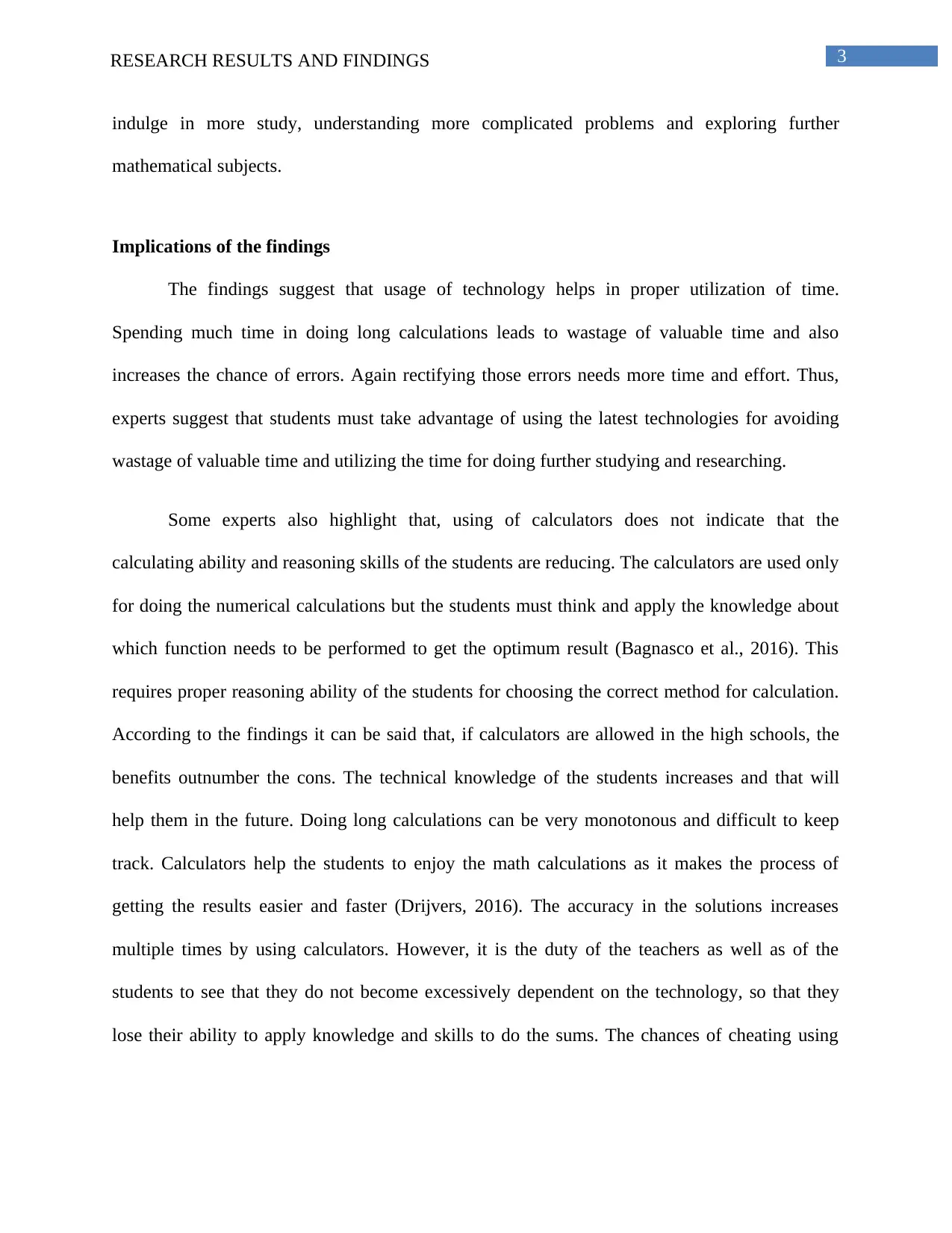
3RESEARCH RESULTS AND FINDINGS
indulge in more study, understanding more complicated problems and exploring further
mathematical subjects.
Implications of the findings
The findings suggest that usage of technology helps in proper utilization of time.
Spending much time in doing long calculations leads to wastage of valuable time and also
increases the chance of errors. Again rectifying those errors needs more time and effort. Thus,
experts suggest that students must take advantage of using the latest technologies for avoiding
wastage of valuable time and utilizing the time for doing further studying and researching.
Some experts also highlight that, using of calculators does not indicate that the
calculating ability and reasoning skills of the students are reducing. The calculators are used only
for doing the numerical calculations but the students must think and apply the knowledge about
which function needs to be performed to get the optimum result (Bagnasco et al., 2016). This
requires proper reasoning ability of the students for choosing the correct method for calculation.
According to the findings it can be said that, if calculators are allowed in the high schools, the
benefits outnumber the cons. The technical knowledge of the students increases and that will
help them in the future. Doing long calculations can be very monotonous and difficult to keep
track. Calculators help the students to enjoy the math calculations as it makes the process of
getting the results easier and faster (Drijvers, 2016). The accuracy in the solutions increases
multiple times by using calculators. However, it is the duty of the teachers as well as of the
students to see that they do not become excessively dependent on the technology, so that they
lose their ability to apply knowledge and skills to do the sums. The chances of cheating using
indulge in more study, understanding more complicated problems and exploring further
mathematical subjects.
Implications of the findings
The findings suggest that usage of technology helps in proper utilization of time.
Spending much time in doing long calculations leads to wastage of valuable time and also
increases the chance of errors. Again rectifying those errors needs more time and effort. Thus,
experts suggest that students must take advantage of using the latest technologies for avoiding
wastage of valuable time and utilizing the time for doing further studying and researching.
Some experts also highlight that, using of calculators does not indicate that the
calculating ability and reasoning skills of the students are reducing. The calculators are used only
for doing the numerical calculations but the students must think and apply the knowledge about
which function needs to be performed to get the optimum result (Bagnasco et al., 2016). This
requires proper reasoning ability of the students for choosing the correct method for calculation.
According to the findings it can be said that, if calculators are allowed in the high schools, the
benefits outnumber the cons. The technical knowledge of the students increases and that will
help them in the future. Doing long calculations can be very monotonous and difficult to keep
track. Calculators help the students to enjoy the math calculations as it makes the process of
getting the results easier and faster (Drijvers, 2016). The accuracy in the solutions increases
multiple times by using calculators. However, it is the duty of the teachers as well as of the
students to see that they do not become excessively dependent on the technology, so that they
lose their ability to apply knowledge and skills to do the sums. The chances of cheating using
Paraphrase This Document
Need a fresh take? Get an instant paraphrase of this document with our AI Paraphraser
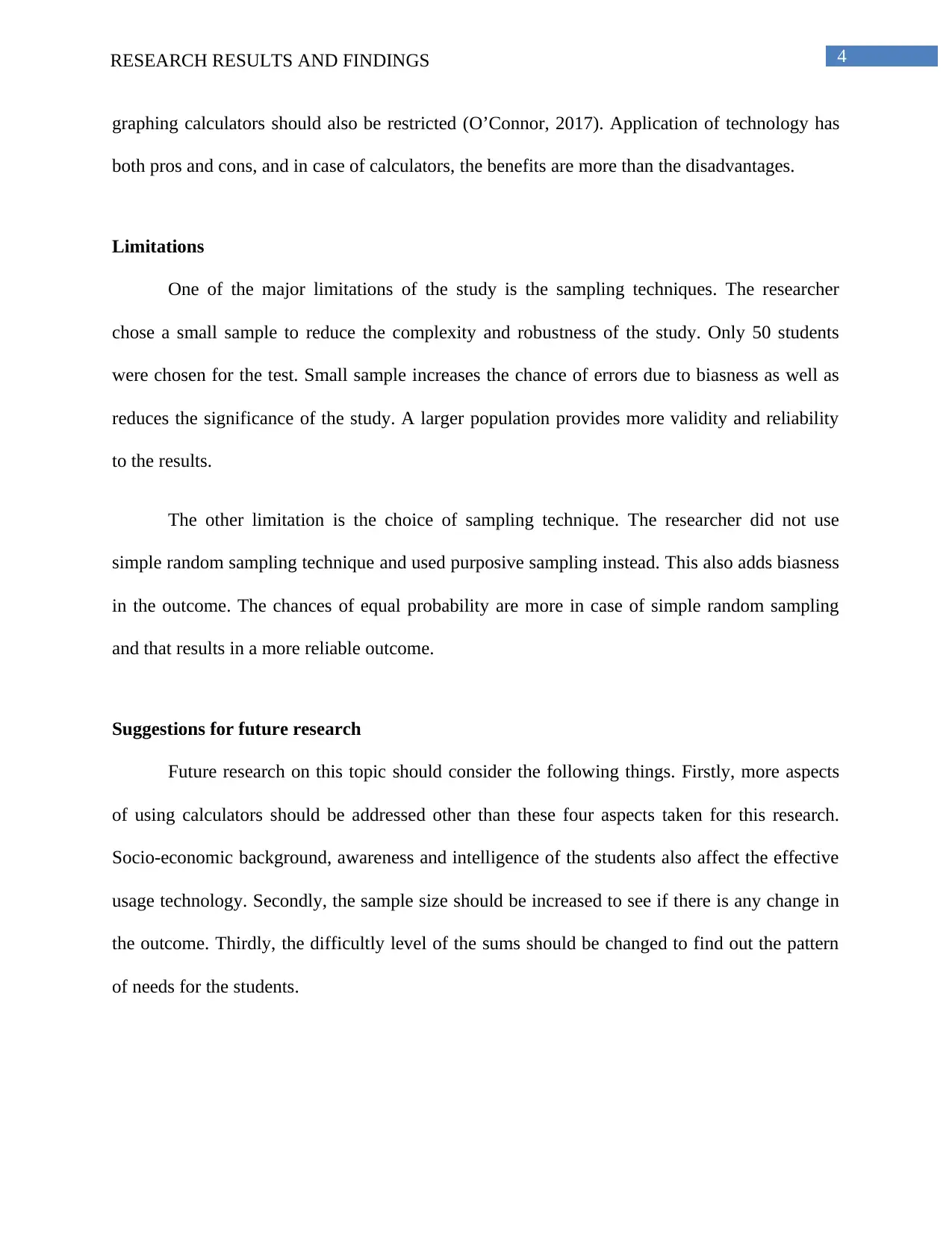
4RESEARCH RESULTS AND FINDINGS
graphing calculators should also be restricted (O’Connor, 2017). Application of technology has
both pros and cons, and in case of calculators, the benefits are more than the disadvantages.
Limitations
One of the major limitations of the study is the sampling techniques. The researcher
chose a small sample to reduce the complexity and robustness of the study. Only 50 students
were chosen for the test. Small sample increases the chance of errors due to biasness as well as
reduces the significance of the study. A larger population provides more validity and reliability
to the results.
The other limitation is the choice of sampling technique. The researcher did not use
simple random sampling technique and used purposive sampling instead. This also adds biasness
in the outcome. The chances of equal probability are more in case of simple random sampling
and that results in a more reliable outcome.
Suggestions for future research
Future research on this topic should consider the following things. Firstly, more aspects
of using calculators should be addressed other than these four aspects taken for this research.
Socio-economic background, awareness and intelligence of the students also affect the effective
usage technology. Secondly, the sample size should be increased to see if there is any change in
the outcome. Thirdly, the difficultly level of the sums should be changed to find out the pattern
of needs for the students.
graphing calculators should also be restricted (O’Connor, 2017). Application of technology has
both pros and cons, and in case of calculators, the benefits are more than the disadvantages.
Limitations
One of the major limitations of the study is the sampling techniques. The researcher
chose a small sample to reduce the complexity and robustness of the study. Only 50 students
were chosen for the test. Small sample increases the chance of errors due to biasness as well as
reduces the significance of the study. A larger population provides more validity and reliability
to the results.
The other limitation is the choice of sampling technique. The researcher did not use
simple random sampling technique and used purposive sampling instead. This also adds biasness
in the outcome. The chances of equal probability are more in case of simple random sampling
and that results in a more reliable outcome.
Suggestions for future research
Future research on this topic should consider the following things. Firstly, more aspects
of using calculators should be addressed other than these four aspects taken for this research.
Socio-economic background, awareness and intelligence of the students also affect the effective
usage technology. Secondly, the sample size should be increased to see if there is any change in
the outcome. Thirdly, the difficultly level of the sums should be changed to find out the pattern
of needs for the students.
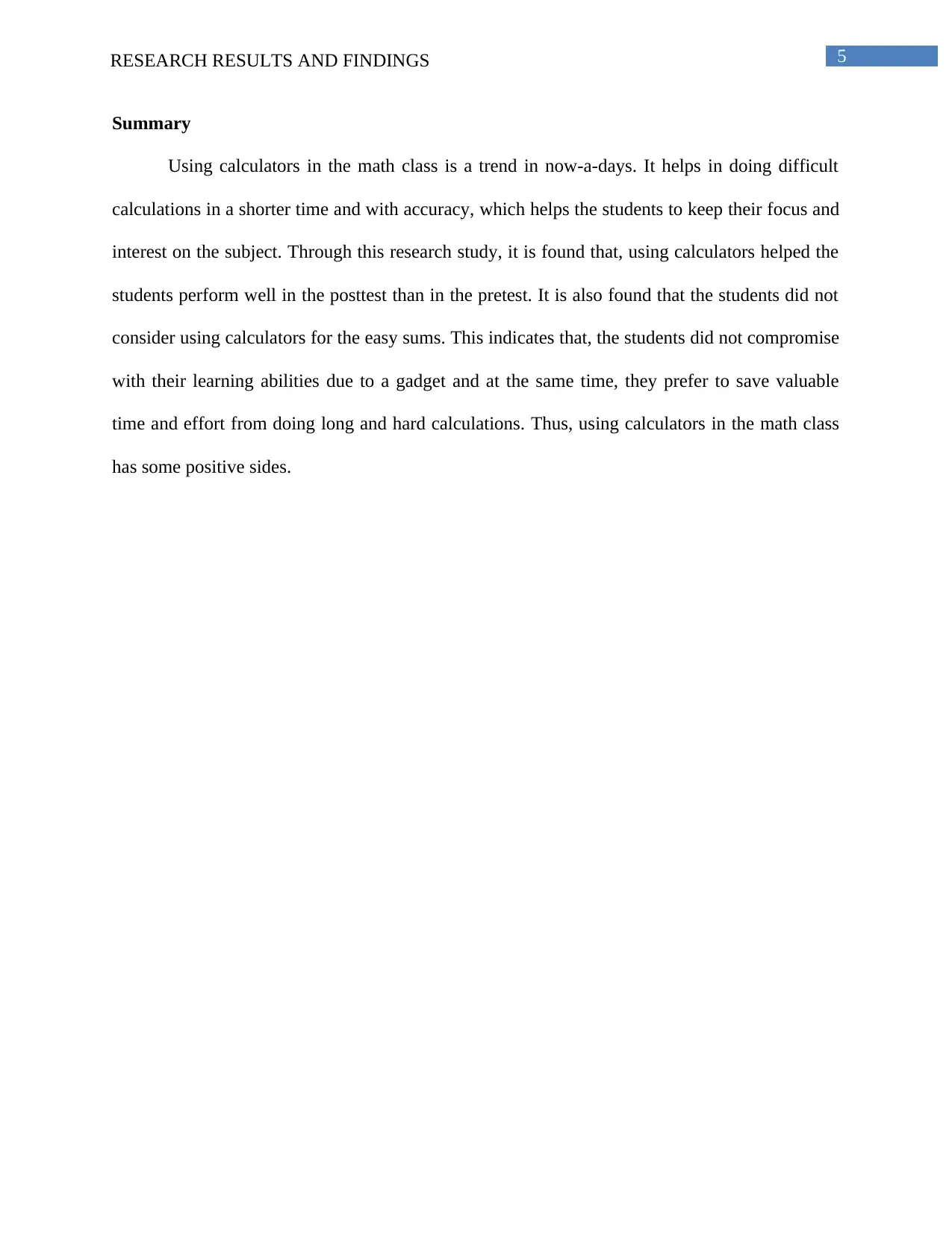
5RESEARCH RESULTS AND FINDINGS
Summary
Using calculators in the math class is a trend in now-a-days. It helps in doing difficult
calculations in a shorter time and with accuracy, which helps the students to keep their focus and
interest on the subject. Through this research study, it is found that, using calculators helped the
students perform well in the posttest than in the pretest. It is also found that the students did not
consider using calculators for the easy sums. This indicates that, the students did not compromise
with their learning abilities due to a gadget and at the same time, they prefer to save valuable
time and effort from doing long and hard calculations. Thus, using calculators in the math class
has some positive sides.
Summary
Using calculators in the math class is a trend in now-a-days. It helps in doing difficult
calculations in a shorter time and with accuracy, which helps the students to keep their focus and
interest on the subject. Through this research study, it is found that, using calculators helped the
students perform well in the posttest than in the pretest. It is also found that the students did not
consider using calculators for the easy sums. This indicates that, the students did not compromise
with their learning abilities due to a gadget and at the same time, they prefer to save valuable
time and effort from doing long and hard calculations. Thus, using calculators in the math class
has some positive sides.
⊘ This is a preview!⊘
Do you want full access?
Subscribe today to unlock all pages.

Trusted by 1+ million students worldwide
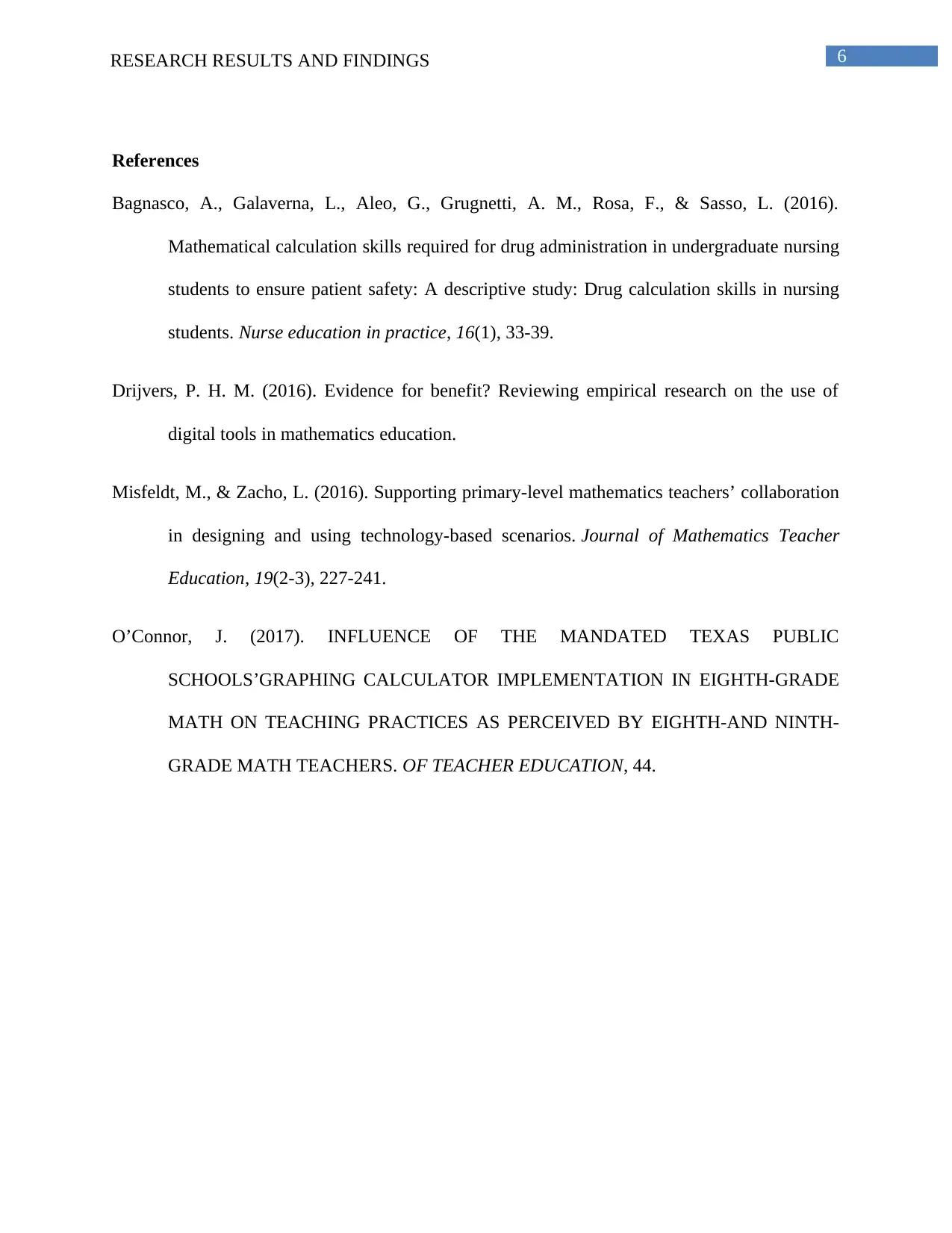
6RESEARCH RESULTS AND FINDINGS
References
Bagnasco, A., Galaverna, L., Aleo, G., Grugnetti, A. M., Rosa, F., & Sasso, L. (2016).
Mathematical calculation skills required for drug administration in undergraduate nursing
students to ensure patient safety: A descriptive study: Drug calculation skills in nursing
students. Nurse education in practice, 16(1), 33-39.
Drijvers, P. H. M. (2016). Evidence for benefit? Reviewing empirical research on the use of
digital tools in mathematics education.
Misfeldt, M., & Zacho, L. (2016). Supporting primary-level mathematics teachers’ collaboration
in designing and using technology-based scenarios. Journal of Mathematics Teacher
Education, 19(2-3), 227-241.
O’Connor, J. (2017). INFLUENCE OF THE MANDATED TEXAS PUBLIC
SCHOOLS’GRAPHING CALCULATOR IMPLEMENTATION IN EIGHTH-GRADE
MATH ON TEACHING PRACTICES AS PERCEIVED BY EIGHTH-AND NINTH-
GRADE MATH TEACHERS. OF TEACHER EDUCATION, 44.
References
Bagnasco, A., Galaverna, L., Aleo, G., Grugnetti, A. M., Rosa, F., & Sasso, L. (2016).
Mathematical calculation skills required for drug administration in undergraduate nursing
students to ensure patient safety: A descriptive study: Drug calculation skills in nursing
students. Nurse education in practice, 16(1), 33-39.
Drijvers, P. H. M. (2016). Evidence for benefit? Reviewing empirical research on the use of
digital tools in mathematics education.
Misfeldt, M., & Zacho, L. (2016). Supporting primary-level mathematics teachers’ collaboration
in designing and using technology-based scenarios. Journal of Mathematics Teacher
Education, 19(2-3), 227-241.
O’Connor, J. (2017). INFLUENCE OF THE MANDATED TEXAS PUBLIC
SCHOOLS’GRAPHING CALCULATOR IMPLEMENTATION IN EIGHTH-GRADE
MATH ON TEACHING PRACTICES AS PERCEIVED BY EIGHTH-AND NINTH-
GRADE MATH TEACHERS. OF TEACHER EDUCATION, 44.
1 out of 7
Related Documents
Your All-in-One AI-Powered Toolkit for Academic Success.
+13062052269
info@desklib.com
Available 24*7 on WhatsApp / Email
![[object Object]](/_next/static/media/star-bottom.7253800d.svg)
Unlock your academic potential
Copyright © 2020–2025 A2Z Services. All Rights Reserved. Developed and managed by ZUCOL.





